280th Station Hospital Unit History

Unofficial insignia of the 280th Station Hospital as it appeared on the Unit’s History held in the US National Archives.
Activation and Training:
The 280th Station Hospital was officially activated at the Army Service Forces Unit Training Center, Camp Ellis, Table Grove, Illinois on 25 June 1943 per GO No 7, HQ, Sixth Service Command. At the time of activation, Lieutenant Colonel Howard W. K. Zellhoefer, MC, was appointed as the Commanding Officer, with Captain Grant L. Otis occupying the position of cadre officer. Additional personnel were rendered in the form of 5 Second Lieutenants (fresh from Officer Candidate School) and 23 Enlisted Men. The parent organisation for the cadre was the 120th Station Hospital, Camp Barkeley, Abilene, Texas (Medical Replacement Training Center). Having originally been activated as a 500-bed establishment, the unit was enlarged and redesignated as a 750-bed Hospital on 25 July 1943, and by 8 August 1943 formal training (under MTP 8-10) had begun. After the first week of orientation and review, approximately 60% of the Enlisted personnel were attending Specialists Schools, while 40% was being unit trained.
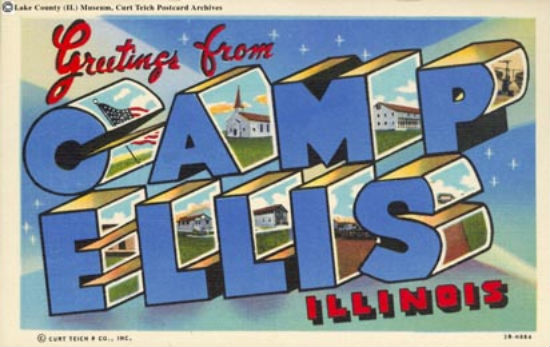
A postcard available for purchase at Camp Ellis. Such cards were typical of training camps and were often purchased by troops and forwarded to loved ones.
On 9 September 1943 the 280th departed Camp Ellis and arrived at Camp Livingston, Alexandria, Louisiana (Army Ground Forces Training Station) two days later. Since there were no Medical Training Schools at the new station, the unit’s Plans and Training Section planned a series of schools to train both professional and administrative Enlisted Men. Practical training was received at the Station Hospital and by 1 October 1943 the unit’s staff had completed its prescribed course under MTP 8-10. On 1 October 1943, the unit saw the arrival of professional Officers to the unit. 75 Nurses were received from Third Service Command and given 4 weeks’ basic training by the unit. Medical Officers were assigned by the Eighth Service Command.
After several inspections, the unit’s readiness date was set for 15 December 1943 and on the following day it left Camp Livingston for Camp Kilmer, Stelton, New Jersey (Staging Area New York Port of Embarkation) and in turn the New York P/E. After a short staging period, the 280th Sta Hosp set sail for the United Kingdom on 23 December 1943 aboard RMS Queen Mary. The journey was completed 7 days later with the unit arriving at Glasgow on 30 December 1943.
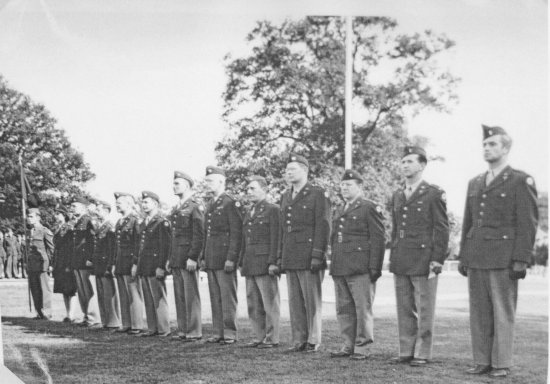
Photograph show senior staff of the Hospital, taken in August 1944. From left to right:
1st Lt. Irmgard M. Sheldon, Principle Chief Nurse
1st Lt. Nelson R. Hatch, Detachment Commander
Capt. Frank H. Zappacosta, Chief of Outpatient Services
Maj. Grant L. Otis, Chief of Medical Service
Lt. Col. Emile C. Bliem, Chief of Dental Service
Col. Howard W. K. Zellhoefer, Commanding Officer
Maj. James H. Spencer, Jr., Chief of Surgical Service
Capt. David R. Climenko, Chief of Laboratory Service
Capt. Walter T. Hileman, Chief of X-Ray Service
Capt. William R. Spence, Senior Chaplain
1st Lt. Harry P. Shelley, Adjutant
1st Lt. Maurice M. Leifer, Registrar
United Kingdom:
Upon arrival at EBS Transient Camp No 1, Cambridge, England, the unit once again plunged into a period of training and preparation for the opening of its Hospital at Shortgrove Park, Newport, Essex. During this period, an advance party was already at the site (which had been selected some weeks prior to the organization’s arrival) and a detachment from the 364th Engineer General Service Regiment (Colored) was at work preparing the grounds. This Hospital was to be an experiment by Major General Paul R. Hawley (Chief Surgeon > ETO) designed to supply the answer to a “scorched earth” policy by the Germans. The plan was a long term construction problem consisting of a series of phases, the first of which was a General or large Station Hospital operating entirely under tentage. The mission of the 280th was “to establish a 750-bed Station Hospital operating entirely under canvas.”
Members of the unit all assisted with the work necessary to prepare the grounds for the Hospital. On 2 January 1944, Colonel Howard W. K. Zellhoefer (CO) and Lt. Colonel Paul C. Sheldon (XO) moved to Shortgrove Park to advise the engineers on the construction of the hospital plant, and between 8 and 11 January, Headquarters and 71 Enlisted Men were moved to assist with the operation. Once the main road through the hospital area had been completed, concrete floors were laid so that more men could be moved in to assist the engineers.
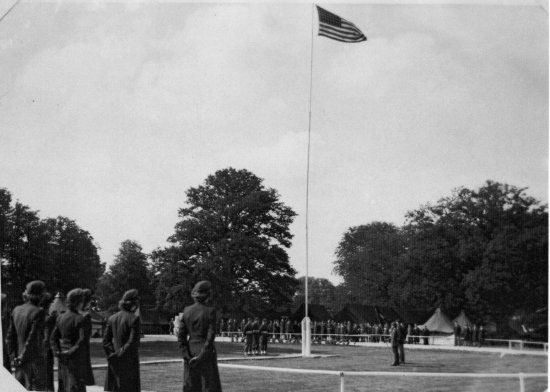
Illustration showing a flag raising ceremony at the unit during its time at the Shortgrove Estate.
With additional quarters having been made available, more Officers and Enlisted Men were moved to the Shortgrove Park site. By 19 February 1944, 18 Officers and 201 Enlisted Men were present. The unit’s Nurses had been separated at debarkation and were now divided into three Detachments at the 121st Station Hospital, the 49th Station Hospital and the 30th General Hospital, and since quarters were not yet available for them, they did not rejoin the unit until a later date.
On 9 January 1944, Detachment “A”, 280th Station Hospital was activated at Hull (England) with a mission “to set up and operate a 50-bed dispensary.” This Detachment consisted of 10 Officers, 8 Nurses and 40 Enlisted Men, with Captain Robert L. Kasha being placed in command.
By 5 March 1944, the Nurses’ quarters were ready and on 9 March all of the unit’s Nurses reported for duty. They immediately set to work in fixing up their quarters and wards. Ward Officers, Nurses and Ward Men worked together setting up beds, putting in bedside tables, painting where and when possible, securing ward supplies, establishing sterilizing and storage tents, installing latrines and preparing diet kitchens. Clinic personnel were busy laying out their clinics, devising and erecting improvised “gadgets” adapted for use in a tented installation where materials and equipment were scarce.
Formal opening day for the Hospital was 1 April 1944, as per Letter, Headquarters, European Theater of Operations, dated 7 April 1944. Although technically prepared to receive emergency cases, there was still work to be carried out on the facility, largely due to difficulties in obtaining plumbing and electrical equipment and supplies. On 15 April, the unit received its first patients – 24 convalescents from the 1st General Hospital. This first group of patients was followed by 12 other Hospital Train cars averaging 44 patients per car. The facility was located in the center of 7 Army Air Corps installations and served a military population of approximately 25,000.
On 3 May 1944, Major General P. R. Hawley inspected the unit and a Retreat Parade was held in his honor. The General was more than satisfied with “his” project, so much so in fact that the installation became “Exhibit A” for all Hospital Commanders, Base Surgeons and their respective staffs. In the six weeks that followed, the unit received 375 Officers visiting the installation. Another result of the ETO Surgeon’s visit was Administrative Memorandum No 127, dated 14 August 1944, authorizing the 280th Station Hospital to function as a General Hospital.
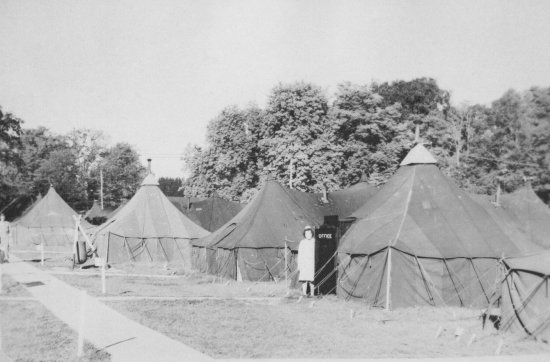
Pyramidal Tents of the 280th Station Hospital erected on the estate at Shortgrove Park.
Following D-Day, Officers, Nurses and Enlisted Men were eagerly looking forward to treating battle casualties, and on 15 July 1944, notification was given that the unit would receive a Hospital Train with 279 battle casualties, all of whom had only been treated by an Evacuation and a Transient Hospital before arrival. The lengthy training sessions and numerous “dry runs” meant that only 105 minutes were needed from the first patient being received from the Train, to the final one being placed in a bed within the Hospital. Once the bed capacity had dropped sufficiently, the Hospital received a further Train load of battle casualties on 5 August 1944.
Telephone orders were received on 15 September 1944 for all the patients to be evacuated from the 280th. 150 of them were sent to the 121st Station Hospital, with the remaining being transferred to the 136th Station Hospital. Within twenty-four hours, all patients had been evacuated and the staff began preparation for movement to the continent; France. Preliminary Movement Warning Orders were received on 21 September 1944, with Final Movement Orders following on 2 October 1944. The next day, the marching column and vehicle convoy departed the Shortgrove estate arriving at the Southampton Marshalling Area on the evening on 3 October. 6 days later, the entire unit boarded the old P&O Liner, Llangibby Castle.
France:
The unit landed at Utah Beach after a short delay due to rough weather on the same day (3 October 1944). The unit spent two and a half weeks in staging, and moved to Cherbourg on 26 October 1944, where it took over Hospital Plant No. 4266, which had previously been operated by the 298th General Hospital. The facility, l’Hôpital Maritime was an old French Naval Hospital constructed in the late 1870s. It had been occupied by the Germans when France was conquered, and had later been home to the 12th Field Hospital immediately following the fall of Cherbourg some months earlier. Due to the heavy casualty load the previous units had received, the buildings of the complex were in dire need of repair and maintenance work. The 280th, although a 750-bed unit, took over a 1,000-bed Hospital of which 400 beds were to comprise a Holding Unit in the evacuation chain, and 600 beds were to be used for normal Station Hospital duties.
A bomb shelter basement located under the west wing of the facility was converted into a medical supply warehouse. A bomb shelter Operating Room and a series of small receiving wards opposite the west wing were converted into an emergency expansion ward, capable of holding 30 additional beds. Because of the great deal of repair and maintenance necessary in the building, the Utilities Department became an important cog in the functioning of the Hospital. Other small basement rooms were converted into a Plumbing Shop, Utilities Office and Electrical Shop, Paint Room and a Tool Room. An additional bomb shelter basement under the east wing of the building was established as the Patients’ Baggage and Clothing Room. Unit Supply and Transportation were located in the far west section of the grounds, and housed in corrugated tin buildings. The American Red Cross occupied one half of the attic in the east wing, with the other half being utilized for a theater with a seating capacity of 300.
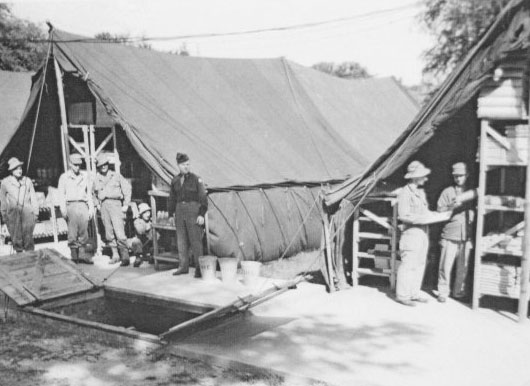
Illustration showing numerous Large Wall Tents being used for storage and supply purposes. Unfortunately, the location of the photograph is unknown to the authors.
The Holding Unit was a unique feature of the Hospital, functioning essentially as a hospital within a hospital. As originally planned, a Medical Corps Officer was assigned to duty with the Holding Unit in addition to his regular duties. All records were handled by the Receiving and Evacuation, and Registrar’s Offices. As time progressed, it became evident that the organization did require the services of a full-time Officer of considerable experience in the practice of medicine and administrative ability.
On 15 November 1944 the unit’s Commanding Officer, Colonel Howard W. K. Zellhoefer, received orders transferring him to the 40th General Hospital which at the time was located in Paris. Lt. Colonel Robert T. Gants joined the unit and assumed the role of CO on 17 November 1944. Prior to his assignment to the 280th, Lt. Colonel R. T. Gants had served as a Regular Army Officer in charge of the Operations Division, Office of the Surgeon General, Seine Section, Communications Zone, European Theater of Operations. He arrived in the ETO on 15 March 1944 and served with the Medical Section, Headquarters, Twelfth Army Group until 1 September 1944 when he was assigned to the Seine Section.
Further changes were made to the staff of the 280th Sta Hosp on 17 December 1944 when Major. Grant L. Otis was transferred to the 40th General Hospital to become Executive Officer under Colonel H. W. K. Zellhoefer. Major William A. Petry, transferred from the 100th General Hospital was appointed Chief of Medical Service. Lt. Colonel James H Spencer Jr., Chief of Surgical Service was transferred to the Medical Section, Normandy Base Section. Major Merle J. Brown, transferred from the 176th General Hospital was appointed as the new Chief of Surgical Service.
On Christmas Eve 1944, the unit had its closest contact with the war. A troopship (SS Léopoldville, carrying reinforcements for the 66th Infantry Division was torpedoed and sunk with great loss of life) was sunk in the Channel near to Cherbourg. The unit was alerted at 1830 hours, and all personnel were retained at the Hospital. Between 2000 hours and 0100 hours, 564 victims were admitted. The cases were primarily submersion cases, but there were many surgical cases as well as pneumonia cases.

Hospital personnel engage in a friendly game of baseball during a quiet period in activities.
During 1944, statistics reveal that the 280th admitted 8,095 patients for a total of 69,447 patient days. A total of 11,717 outpatients were seen for a total of 19,232 treatments. It should be remembered that the unit had only, in reality, served as a functioning hospital for seven months of the year; five months in the United Kingdom and 2 months in France.
While operating at Shortgrove Park, the Hospital was entirely self-sufficient. No civilian workers or attached personnel were used. However at the larger and much busier Cherbourg Hospital, additional help was needed. Consequently, French civilians were hired for maintenance, janitor and kitchen work. In addition, a detachment of 100 captured German Protected Personnel (enemy medical personnel) were put to work at the installation. These men were Prisoners of War and members of the German Medical and Sanitary units protected under the provisions of the Geneva Convention. After having constructed their own enclosure, these men were put to work in small details about the Hospital and were utilized as litter bearers in cases of mass admission, disposition, or evacuation of patients.
On 8 May 1945 the 280th Station Hospital was functioning as a Station and Holding Hospital at Tourlaville, France. This hospital operated 250-beds as a Station Hospital section. Thus there was a Holding Section and a Station Hospital Section.

Overview of the 280th Station Hospital showing the arrangement and vast array of tentage used by the unit.
The physical plant at Tourlaville consisted of tents uniformly laid out to form nine blocks of tentage with six wards to each block. 7 blocks were used for the holding patients, one was used for patients with Officer status, and the remaining block was for Enlisted patients of the Cherbourg area. All of the wards had concrete floors, and the roadways between the blocks were made of either gravel, concrete, or asphalt. There was running water to at least one tent in each block and each block had its own auxiliary kitchen, but ambulatory patients went to a large central Patients’ Mess which was located in a prefabricated building. The latrine facilities were of the outdoor bucket type located in a latrine tent in each block area. The patients’ baggage was initially kept in a central baggage room or tent but later, enough tents were obtained and baggage tents were set up for each block which proved more satisfactory.
During this period, a few of the Hospital’s personnel were lost to units that were scheduled to redeploy to the Pacific Theater of Operations. These were, for the most part, those who had the lowest points. Training of Replacements was not a great problem as most of them were already trained.
The Hospital closed for further admissions on 6 August 1945. The remaining holding patients were either evacuated by Hospital Ship to the Zone of Interior or were transferred to the 196th General Hospital which remained in operation. During the month that followed, tents were struck and turned in, and the entire 1,000-bed assembly was packed for movement to Marburg, Germany. Most of the movement was made by train. The main party left Cherbourg 7 September 1945. A small part of the personnel and equipment made the trip by truck with the advance party.
Germany:
The 280th Station Hospital arrived at Marburg, Germany on 10 September 1945, in the Kaserne Tannenberg which was situated on a large hill approximately two miles northwest of Marburg. The Kaserne was already home to Hospital Plant No. 4467 which was operated by the 41st Evacuation Hospital. This unit continued to operate until the organization set up and began operations on 18 September 1945.
The physical plant consisted of a former German military barracks of five four-storey buildings and numerous small one-storey buildings. All of the buildings required considerable alterations and repairs to make them suitable for hospital operation. Work was immediately begun for the conversion and remodeling of the plant into a 750-bed Station Hospital during the latter part of September 1945. The construction being performed largely by a German civilian contractor using German civilian and PW labor under the supervision of an Army Engineer unit. During this time, all hospital facilities were operated in two of the four-storey buildings, the Medical Detachment occupying one four-storey building and one being used for Officers’ and Enlisted Men’s Mess and for Nurses’ Quarters.
After taking over from the 41st Evacuation Hospital, Station Hospital equipment was issued to all departments and many changes were made in the Hospital arrangement. The Surgical Service was composed of 5 wards with a bed capacity of 187 and in addition the Surgical Service operated outpatient clinics, central supply and physiotherapy. There was a total of 188 patients in the hospital when the unit took over. During the period 17 September 1945 to 31 December 1945, the daily patient census averaged around 200.
In the period from 18 September 1945 to 10 December 1945, 17 major and 270 minor operations were performed. There were 924 outpatients referred to Surgical Clinics and 1,028 treatments given. In addition, 137 in-patients consultations were referred to the Surgical Service. From 16 September 1945 to 10 December 1945, 392 patients had been hospitalized and discharged leaving a remainder of 88 patients on the service. Due to the 120-day hospitalization plan, only a small percentage of patients had been evacuated to the Zone of Interior by this date.
Work continued to improve the facility, and during May 1946 the reconversion of one four-storey building was completed and the first three floors were used for Wards, while the basement was converted for use as a PX and ice cream parlor. The fourth floor was used for American Red Cross facilities. In the second building, which was being reconverted, only the three upper floors were completed. The fourth floor being used for a Nurses’ quarters and the third floor as Wards, while the first and second floors were used for Officers’ quarters and offices. Other similar one-storey buildings were used for utilities, garage and operation offices for the constructing Engineers.
The space provided for the operation of a 750-bed Hospital as a whole was inadequate. However, had all construction been completed as originally planned, there would have been sufficient space for the operation of a complete 500-bed Station Hospital. The use of such plans for hospitals was not as economical as planned due to the separation of the buildings. Therefore, a great deal of manpower was wasted in traveling from one building to another, plus the fact that adequate facilities could not be made available for the care and treatment of patients without many alterations and repairs. On 1 April 1946, the bed capacity of the Hospital was gradually reduced from 750 to 500 beds.
During the month of June 1946, all construction work on the Hospital was stopped and information was received to the effect that the patient load at the Hospital did not warrant its continued operation and that, as of 31 August 1946, it would be closed at Marburg and moved to Lesum, Germany. The decrease in the patient census was due to the opening of the 388th Station Hospital at Giessen and the reduction in strength or inactivation of many units formerly served by the 280th Station Hospital in the Marburg area.
On 10 September 1946, the 280th Station Hospital was moved from Marburg to Bremen-Lesum, a distance of approximately 250 miles. The movement of all equipment was accomplished by motor vehicles furnished by the 242d and 243d Transportation Truck Companies and was also supplemented by the unit’s organic vehicles. The personnel were mostly transported by rail. The advance party arrived during the last part of August and other groups of personnel moved as their departments were closed. A few Officers remained behind to close the Hospital in Marburg and only rejoined the organization at the new location on 25 September 1946 after turning the plant over to the 69th Battalion, 3d Replacement Depot. During the move, there was very little loss or damage to supplies and equipment. Upon arrival at Bremen-Lesum the 280th Station Hospital took over the location which was formerly occupied by Detachment “A”, 121st General Hospital in Bremerhaven and the 636th Medical Clearing Company which was stationed on the post at the time to assist the Detachment with its mission.
At the site of the new Hospital in Lesum, there were a total of 32 buildings, 28 of which were of brick construction. All of them were one-storey buildings, except four and were widely distributed over a 78-acre site. The premises had been first occupied by American troops of the 29th Infantry Division during May 1945 and subsequently by Quartermaster Corps troops in the latter part of June 1945. A small detachment of the 121st General Hospital moved into the area and maintained a dispensary until April 1946.
The authors would like to thank British WW2 Historian Tony Honeyman who kindly forwarded the necessary data to compile this Unit History. Unfortunately, official records at the US National Archives do not include information relating to the unit’s return to the ZI or indeed its deactivation date. Any information that could assist in providing the missing data as well as a Personnel Roster would be most gratefully received.
